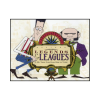-
The Story of the World: Volume 3 Early Modern Times (Activity Book) $57.95 QTY: 1Quantity
-
Legends and Leagues - Storybook $20.95 QTY: 1Quantity
-
The Story of the World, Volume 2: The Middle Ages - Text (Revised Edition) $25.95 QTY: 1Quantity
Out Of Stock
Ada Lovelace: Programming the Future
In 1822, Charles Babbage designed the “Analytical Engine,” which was in effect the first computer. Although the machine was never built, an editor hired Ada Lovelace to write about it. Lovelace had studied advanced mathematics, which was rare for women at that time, and she went beyond what Babbage had done, expressing breakthrough ideas that are at the foundations of modern computer science.
$19.50
Out of stock
Description
In 1822, Englishman Charles Babbage designed a mechanical device for performing calculations that he called the “Difference Engine.” For years the British government poured money into the creation of the device, but it was never what Babbage wanted it to be. He was forever revising it based on new ideas and inspirations, and ultimately he designed a new machine that would be even more powerful, which he called the “Analytical Engine.” It would be, in effect, the first computer.
The problem was that Babbage had no way to build his machine, but his idea caught the attention of several scientists and other men of influence. One, from Italy, wrote about the Analytical Engine in detail, and a London editor wanted that information translated. For that he turned to a countess named Ada Lovelace. Lovelace had known Babbage since the dawn of his Difference Engine, and she had worked hard to study advanced mathematics at levels that were rare for women during that era. She understood the Analytical Engine, so she not only translated the information about it; she added detailed notes to the translation that explained the machine in plainer language. And, more importantly, she went even further than Babbage had and expressed some breakthrough ideas that are at the foundations of modern computer science.
Unfortunately, Babbage never built his Analytical Engine, but about a hundred years later, women picked up the torch that Lovelace had lit and carried it forward into computer science in ways that Babbage and Lovelace could hardly have envisioned. The women who worked on the first computers for the U.S. government during World War II and soon after were the first computer programmers and the first software engineers. The computer technology that we enjoy today is in large part the result of their efforts, and it is built on Ada Lovelace’s digital legacy.
There’s a “Doing the Math” section at the end of the book so that readers can try working out the math themselves!
Useful Links:
Listen to Robert Black talk about the Mathematical Lives series in the Breaking Math podcast.
Titles in Series:
Edward Lorenz and the Chaotic Butterflies
Benoit Mandelbrot: Reshaping the World
Ada Lovelace: Programming the Future
Florence Nightingale: The Lady with the Diagrams
Pascal and Fermat: The Probability Pen Pals
David Blackwell and the Deadliest Duel
Additional information
| Weight | .6 kg |
|---|---|
| Dimensions | 11 × 8.5 × .5 in |
| ISBN 13 | 9780880923033 |
| Author | Robert Black |
| Publisher | Royal Fireworks Press |
| Format | Paperback |



















Reviews
There are no reviews yet